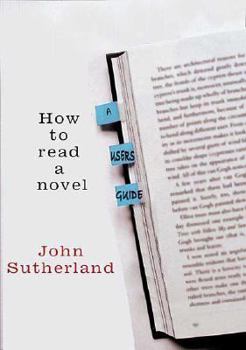How to Read a Novel: A User's Guide
Select Format
Select Condition 
Book Overview
"Do we still know how to read a novel?" John Sutherland, Chairman of the 2005 Booker Prize Committee, asks. His disheartened answer is an unequivocal, "No." But Sutherland has not given up hope. With acerbic wit and intellect, he traces the history of what it used to mean to be well-read and tells readers what it still means today. Using this delightful book as a means to an end, he reminds readers how the delicate charms of fiction can be at once...
Format:Hardcover
Language:English
ISBN:0312359888
ISBN13:9780312359881
Release Date:October 2006
Publisher:St. Martin's Press
Length:263 Pages
Weight:1.00 lbs.
Dimensions:1.0" x 5.8" x 8.5"
Customer Reviews
2 ratings
Devoted non-fiction reader is now fired up to read novels
Published by Thriftbooks.com User , 17 years ago
When I head to the book store or library, I have always zipped right by the racks of new novels for the non-fiction section (where I picked up this book) -- but John Sutherland has so charmed me with his observations about the history and uses of fiction, that I will now be plunging into novels for the first time since college. He references no fewer than 400 notable works spanning hundreds of years in a mere 240 pages and includes illustrations of title pages and covers from many notable novels dating back to the 1719 edition of Robinson Crusoe. His passion for and intimate familiarity with so much great fiction is infectious.
"So many novels, so little time."
Published by Thriftbooks.com User , 18 years ago
John Sutherland's splendid "How to Read a Novel" is a comprehensive guidebook to an art form that is very dear to my librarian's heart. Sutherland's credentials are impressive: he has taught Modern English Literature at University College London, served as the committee chairman for the 2005 Man Booker Prize, and writes for such prestigious publications as The Guardian and The London Review of Books. Sutherland's professed goal is to help overwhelmed book borrowers and purchasers make more informed choices than they would by merely browsing through their local library or bookstore. The author is nothing if not thorough, covering everything from the history of the novel (its format has changed surprisingly little over time) to its many distinct parts, including the dust jacket, copyright page, title, epigraph, foreword, afterword, opening, conclusion, and even the font. How much stock should we put in blurbs that gushingly declare a suspense novel to be "taut and riveting"? Would we better off slavishly following the advice of some curmudgeonly critic who urges us to avoid the very same novel, since it is hackneyed and melodramatic tripe? Is an intimate knowledge of the cultural background and setting of a book indispensable to its appreciation? What role does genre play in a reader's enjoyment of a particular work of fiction? What factors go into making one book a bestseller and/or a literary prize winner while another is quickly forgotten and dumped into a store's remainder bin? Can movies and novels coexist comfortably or do cinematic adaptations inevitably destroy our enjoyment of the printed work on which the movie is based? Do novels have any lasting value beyond their ability to entertain us for a few hours? The well-read, highly literate, and somewhat opinionated Sutherland brilliantly and amusingly answers these and other lively questions. Although I am a presumably knowledgeable librarian, the author's occasionally arcane prose had me checking the meaning of quite a few unfamiliar words and allusions (costive, belletristic, Zoilism, to name a few) that permeate this book. In addition, "How to Read a Novel" is geared more to a British than an American audience; the British cultural references may have some readers on my side of the Atlantic scratching their heads in bewilderment. I was none too pleased with Sutherland's derisive (although obviously tongue-in-cheek) attitude towards librarians. He tars us all with one brush as being narrow-minded fussbudgets. Shame on you, Mr. Sutherland! However, these quibbles are offset by the author's exuberant love of reading and his understanding of what makes a novel addict come back time and time again for another fix. In "How to Read a Novel," John Sutherland takes us on a delightful and entertaining journey, citing numerous passages from such works as Zadie Smith's "On Beauty," Ian McEwen's "Saturday," Michael Cunningham's "The Hours," Salman Rushdie's "Shalimar the Clown," and





